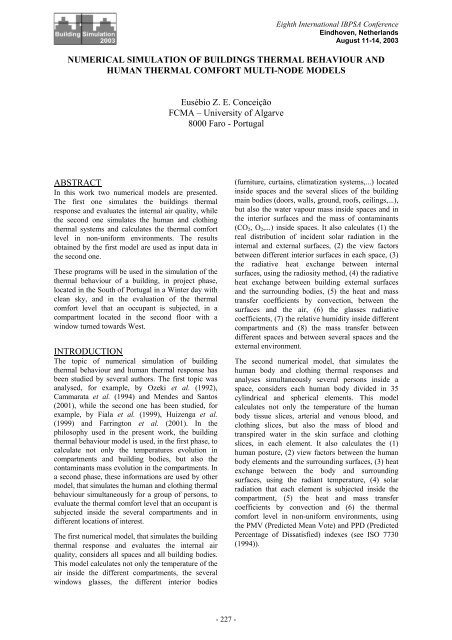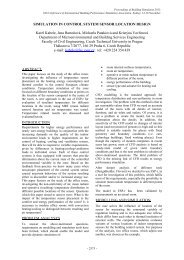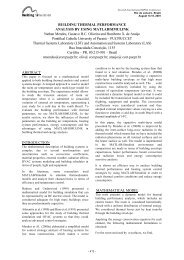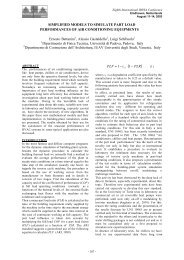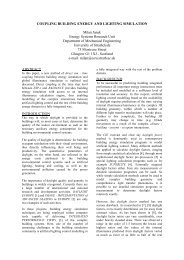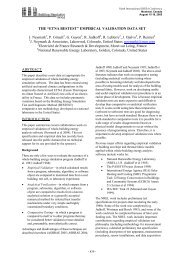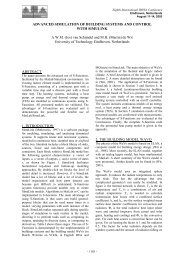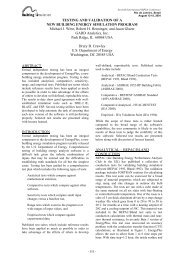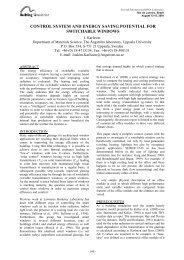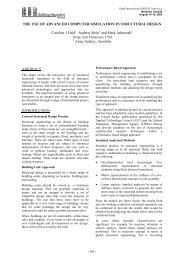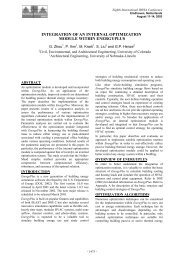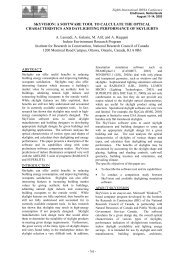numerical simulation of buildings thermal behaviour and ... - ibpsa
numerical simulation of buildings thermal behaviour and ... - ibpsa
numerical simulation of buildings thermal behaviour and ... - ibpsa
You also want an ePaper? Increase the reach of your titles
YUMPU automatically turns print PDFs into web optimized ePapers that Google loves.
NUMERICAL SIMULATION OF BUILDINGS THERMAL BEHAVIOUR AND<br />
HUMAN THERMAL COMFORT MULTI-NODE MODELS<br />
ABSTRACT<br />
In this work two <strong>numerical</strong> models are presented.<br />
The first one simulates the <strong>buildings</strong> <strong>thermal</strong><br />
response <strong>and</strong> evaluates the internal air quality, while<br />
the second one simulates the human <strong>and</strong> clothing<br />
<strong>thermal</strong> systems <strong>and</strong> calculates the <strong>thermal</strong> comfort<br />
level in non-uniform environments. The results<br />
obtained by the first model are used as input data in<br />
the second one.<br />
These programs will be used in the <strong>simulation</strong> <strong>of</strong> the<br />
<strong>thermal</strong> <strong>behaviour</strong> <strong>of</strong> a building, in project phase,<br />
located in the South <strong>of</strong> Portugal in a Winter day with<br />
clean sky, <strong>and</strong> in the evaluation <strong>of</strong> the <strong>thermal</strong><br />
comfort level that an occupant is subjected, in a<br />
compartment located in the second floor with a<br />
window turned towards West.<br />
INTRODUCTION<br />
The topic <strong>of</strong> <strong>numerical</strong> <strong>simulation</strong> <strong>of</strong> building<br />
<strong>thermal</strong> <strong>behaviour</strong> <strong>and</strong> human <strong>thermal</strong> response has<br />
been studied by several authors. The first topic was<br />
analysed, for example, by Ozeki et al. (1992),<br />
Cammarata et al. (1994) <strong>and</strong> Mendes <strong>and</strong> Santos<br />
(2001), while the second one has been studied, for<br />
example, by Fiala et al. (1999), Huizenga et al.<br />
(1999) <strong>and</strong> Farrington et al. (2001). In the<br />
philosophy used in the present work, the building<br />
<strong>thermal</strong> <strong>behaviour</strong> model is used, in the first phase, to<br />
calculate not only the temperatures evolution in<br />
compartments <strong>and</strong> building bodies, but also the<br />
contaminants mass evolution in the compartments. In<br />
a second phase, these informations are used by other<br />
model, that simulates the human <strong>and</strong> clothing <strong>thermal</strong><br />
<strong>behaviour</strong> simultaneously for a group <strong>of</strong> persons, to<br />
evaluate the <strong>thermal</strong> comfort level that an occupant is<br />
subjected inside the several compartments <strong>and</strong> in<br />
different locations <strong>of</strong> interest.<br />
The first <strong>numerical</strong> model, that simulates the building<br />
<strong>thermal</strong> response <strong>and</strong> evaluates the internal air<br />
quality, considers all spaces <strong>and</strong> all building bodies.<br />
This model calculates not only the temperature <strong>of</strong> the<br />
air inside the different compartments, the several<br />
windows glasses, the different interior bodies<br />
Eusébio Z. E. Conceição<br />
FCMA – University <strong>of</strong> Algarve<br />
8000 Faro - Portugal<br />
- 227 -<br />
Eighth International IBPSA Conference<br />
Eindhoven, Netherl<strong>and</strong>s<br />
August 11-14, 2003<br />
(furniture, curtains, climatization systems,...) located<br />
inside spaces <strong>and</strong> the several slices <strong>of</strong> the building<br />
main bodies (doors, walls, ground, ro<strong>of</strong>s, ceilings,...),<br />
but also the water vapour mass inside spaces <strong>and</strong> in<br />
the interior surfaces <strong>and</strong> the mass <strong>of</strong> contaminants<br />
(CO2, O2,...) inside spaces. It also calculates (1) the<br />
real distribution <strong>of</strong> incident solar radiation in the<br />
internal <strong>and</strong> external surfaces, (2) the view factors<br />
between different interior surfaces in each space, (3)<br />
the radiative heat exchange between internal<br />
surfaces, using the radiosity method, (4) the radiative<br />
heat exchange between building external surfaces<br />
<strong>and</strong> the surrounding bodies, (5) the heat <strong>and</strong> mass<br />
transfer coefficients by convection, between the<br />
surfaces <strong>and</strong> the air, (6) the glasses radiative<br />
coefficients, (7) the relative humidity inside different<br />
compartments <strong>and</strong> (8) the mass transfer between<br />
different spaces <strong>and</strong> between several spaces <strong>and</strong> the<br />
external environment.<br />
The second <strong>numerical</strong> model, that simulates the<br />
human body <strong>and</strong> clothing <strong>thermal</strong> responses <strong>and</strong><br />
analyses simultaneously several persons inside a<br />
space, considers each human body divided in 35<br />
cylindrical <strong>and</strong> spherical elements. This model<br />
calculates not only the temperature <strong>of</strong> the human<br />
body tissue slices, arterial <strong>and</strong> venous blood, <strong>and</strong><br />
clothing slices, but also the mass <strong>of</strong> blood <strong>and</strong><br />
transpired water in the skin surface <strong>and</strong> clothing<br />
slices, in each element. It also calculates the (1)<br />
human posture, (2) view factors between the human<br />
body elements <strong>and</strong> the surrounding surfaces, (3) heat<br />
exchange between the body <strong>and</strong> surrounding<br />
surfaces, using the radiant temperature, (4) solar<br />
radiation that each element is subjected inside the<br />
compartment, (5) the heat <strong>and</strong> mass transfer<br />
coefficients by convection <strong>and</strong> (6) the <strong>thermal</strong><br />
comfort level in non-uniform environments, using<br />
the PMV (Predicted Mean Vote) <strong>and</strong> PPD (Predicted<br />
Percentage <strong>of</strong> Dissatisfied) indexes (see ISO 7730<br />
(1994)).
INPUT DATA<br />
The input data used by the <strong>buildings</strong> <strong>thermal</strong><br />
<strong>behaviour</strong> model are the tridimensional geometry, the<br />
materials <strong>thermal</strong> proprieties <strong>and</strong> other conditions.<br />
Firstly, all spaces are identified. The compartments<br />
geometry is defined through the introduction <strong>of</strong><br />
involving bodies: building main bodies <strong>and</strong> windows<br />
glasses bodies. These bodies, with complex<br />
geometry, that are associated to the boundary <strong>of</strong> two<br />
compartments (or <strong>of</strong> a compartment <strong>and</strong> the external<br />
environment), are flat. As the main bodies are<br />
divided in several slices, in order to simulate the<br />
<strong>thermal</strong> stratification verified in these bodies, it is<br />
also necessary to identify the slices thickness. In the<br />
compartments geometry is important to introduce the<br />
more relevant interior bodies in the <strong>simulation</strong>. In the<br />
second part, are introduced the main bodies,<br />
windows glasses <strong>and</strong> interior bodies <strong>thermal</strong><br />
proprieties. Finally, it is also necessary to introduce<br />
the external environmental <strong>and</strong> geographical<br />
conditions, the initial conditions <strong>of</strong> the <strong>simulation</strong>,<br />
the heat load released by the human bodies, heating<br />
<strong>and</strong> air-conditioning systems (<strong>and</strong> other internal<br />
sources), air recirculation, air exchanges between<br />
compartments, air exchange between each<br />
compartment <strong>and</strong> the external environment <strong>and</strong> to<br />
identify the internal mass generation <strong>and</strong> its intensity.<br />
The results obtained by the first model, which are<br />
associated to the air mean temperature <strong>and</strong> relative<br />
humidity in the compartment, the surrounding<br />
surfaces temperatures, solar radiation <strong>and</strong><br />
compartment geometry, are used as input data to the<br />
second model. It is also needed to introduce the<br />
occupant’s location <strong>and</strong> to define their postures. The<br />
air velocity around the occupants is also possible to<br />
introduce.<br />
Using these input data the programs built one energy<br />
<strong>and</strong> mass balance integral equations system for the<br />
building <strong>and</strong> a second one for the occupants. In the<br />
resolution <strong>of</strong> these systems is used the Runge-Kutta-<br />
Fehlberg method with error control (see Burden <strong>and</strong><br />
Faires (1985)). The s<strong>of</strong>tware can also visualise the<br />
building <strong>and</strong> occupant geometry or export a file to be<br />
seen in a compatible code.<br />
BUILDING THERMAL BEHAVIOR<br />
The <strong>buildings</strong> <strong>thermal</strong> <strong>behaviour</strong> multi-node model,<br />
that works in transient conditions, is based in energy<br />
<strong>and</strong> mass balance integral equations. The energy<br />
balance integral equation are developed for the air<br />
inside compartments, the windows glasses, the<br />
interior bodies located inside spaces <strong>and</strong> the different<br />
building main bodies, while the mass balance integral<br />
equations are developed for the water vapour inside<br />
spaces <strong>and</strong> in the interior surfaces (main bodies,<br />
windows glasses <strong>and</strong> interior bodies) <strong>and</strong> air<br />
- 228 -<br />
contaminants (CO2, O2, ...) inside spaces. This kind<br />
<strong>of</strong> equations, applied in <strong>buildings</strong>, had been used by<br />
several authors, for example, by Cammarata et al.<br />
(1994), Str<strong>and</strong> et al. (2001) <strong>and</strong> Mendes <strong>and</strong> Santos<br />
(2001).<br />
The model considers the conductive phenomena<br />
between different slices <strong>of</strong> the main bodies. In the<br />
ground is imposed a fixed temperature at a<br />
predefined dept.<br />
There are considered natural, forced <strong>and</strong> mixed<br />
convection phenomena between the internal <strong>and</strong><br />
external <strong>buildings</strong> surfaces <strong>and</strong> the adjacent fluid. In<br />
the determination <strong>of</strong> the heat transfer coefficient by<br />
convection are used empirical expressions published<br />
in specialised bibliography (see, for example, Guyer<br />
<strong>and</strong> Brownell (1999)).<br />
The mass transport phenomena (water vapour <strong>and</strong><br />
other gases) are divided in four parts: mass exchange<br />
between different compartments (1), mass exchange<br />
between each space <strong>and</strong> the external environment (2)<br />
<strong>and</strong> mass generation inside spaces (human<br />
respiration <strong>and</strong> transpiration) (3) (see Berne (1994)).<br />
In the water vapour transport are also considered the<br />
mass exchange between the internal surfaces <strong>and</strong> the<br />
air inside spaces (4). Using the water vapour mass<br />
values <strong>and</strong> the air temperature values the model<br />
calculates the air relative humidity (see ASHRAE<br />
H<strong>and</strong>book (2001)).<br />
Finally, the radiative phenomena (verified inside <strong>and</strong><br />
outside the building), in the present model, are<br />
divided in short-wave <strong>and</strong> long-wave radiation.<br />
In short-wave radiation, associated to the solar<br />
radiation, it is calculated the real distribution <strong>of</strong> the<br />
solar radiation not only in external surfaces (main<br />
bodies <strong>and</strong> windows glasses), but also in the internal<br />
surfaces (main <strong>and</strong> interior bodies). In the external<br />
surfaces (see figure 1a) are calculated the absorbed<br />
<strong>and</strong> reflected radiation in the main bodies <strong>and</strong> the<br />
absorbed, reflected <strong>and</strong> transmitted radiation in the<br />
windows glasses, while in the interior surfaces (see<br />
figure 1b), using the transmitted solar radiation<br />
through the glasses, are calculated the absorbed <strong>and</strong><br />
reflected radiation in the main <strong>and</strong> interior bodies<br />
surfaces (see Ozeki et al. (1992)).<br />
In the long-wave radiation, the model considers not<br />
only the heat exchange between the building external<br />
surfaces <strong>and</strong> the nocturnal sky <strong>and</strong> the surrounding<br />
surfaces (other <strong>buildings</strong>, vegetation,...), during the<br />
day, but also heat exchange between the internal<br />
surfaces (main bodies, windows glasses <strong>and</strong> interior<br />
bodies) <strong>of</strong> each space (see figure 2). The diffuse<br />
radiation between grey surfaces, in each enclosure, is<br />
calculated through the radiosity method, through the
view factors <strong>and</strong> the surfaces temperature (see Ozeki<br />
et al. (1992)).<br />
b)<br />
With external shading effect<br />
With internal shading effect<br />
Without shading effect<br />
Sun direction<br />
Figure 1 – Scheme <strong>of</strong> the real distribution <strong>of</strong> solar<br />
radiation in external (a) <strong>and</strong> internal (b) surfaces with<br />
<strong>and</strong> without shading effect.<br />
b)<br />
Figure 2 – Scheme used in the internal long-wave<br />
radiation with (a) <strong>and</strong> without (b) shading effect.<br />
In the radiative calculus, <strong>of</strong> long-wave <strong>and</strong> shortwave<br />
radiations, are considered the shading effect<br />
a)<br />
a)<br />
- 229 -<br />
caused by the surrounding surfaces (<strong>buildings</strong> or<br />
other obstacles) <strong>and</strong> by internal surfaces (main <strong>and</strong><br />
interior bodies in each compartment) (see Corrado et<br />
al. (1995)). In these calculus all building surfaces<br />
(main bodies, windows glasses <strong>and</strong> interior bodies)<br />
are sub-divided in several small areas (see figures 1<br />
<strong>and</strong> 2).<br />
HUMAN THERMAL COMFORT<br />
In the human <strong>thermal</strong> comfort multi-node model, that<br />
works in transient conditions <strong>and</strong> simultaneously<br />
simulates a group <strong>of</strong> persons, the tridimentional body<br />
is divided in 34 cylindrical <strong>and</strong> 1 spherical elements.<br />
Each element is sub-divided in 12 cylindrical (or<br />
spherical) slices <strong>and</strong> could be still protected from the<br />
external environment through some clothing slices.<br />
More details about this simplified human body can<br />
be analysed, for example, in Conceição (2000),<br />
Conceição <strong>and</strong> Lúcio (2001) or in Conceição <strong>and</strong><br />
Lúcio (2002).<br />
The human <strong>thermal</strong> response is based on energy<br />
balance integral equations for the human body tissue<br />
slices <strong>and</strong> arterial <strong>and</strong> venous blood, as well as mass<br />
balance integral equations for the blood <strong>and</strong><br />
transpired water in the skin surface for each element.<br />
The clothing <strong>thermal</strong> response is based on energy<br />
balance integral equations for the clothing slices, as<br />
well as mass balance integral equations for the<br />
clothing slices in each element. These integral<br />
equations are based in the following phenomena (see<br />
Conceição (2000)): internal metabolism, heat<br />
conduction through the tissue, blood circulatory<br />
convection, heat loss by respiration to the<br />
environment, heat exchange between the body <strong>and</strong><br />
the environment (or clothing) by radiation,<br />
convection, conduction <strong>and</strong> evaporation. To control<br />
the human body temperature is implemented a<br />
model, based in Stolwijk (1970), that simulates the<br />
thermo-regulatory system.<br />
The human body, inside an internal space, is<br />
subjected to short-wave to long-wave radiations. In<br />
this calculus the 35 human body elements <strong>and</strong> the<br />
surrounding external surfaces are divided in small<br />
areas. More details about the grid generation around<br />
the human body <strong>and</strong> in the surrounding surfaces, in<br />
complex topology, can be analysed in Conceição<br />
(2003). The philosophy used in the short-wave<br />
radiation calculus, with the parallel ray method (see,<br />
for example, Ozeki et al. (1998)), can be seen in<br />
figure 3 (a1, b1 <strong>and</strong> c1). To calculate the heat<br />
exchange by radiation between the human body<br />
external surface <strong>and</strong> the surrounding surfaces are<br />
used the mean radiant temperature (see Fanger<br />
(1970)). These calculus are based in the view factors<br />
<strong>and</strong> in the surrounding surface temperatures (see<br />
figure 3 (a2, b2 <strong>and</strong> c2)). In the radiative calculus,
long-wave <strong>and</strong> short-wave radiations, were<br />
considered the shading effect <strong>of</strong> the human body<br />
elements (see figure 3b) <strong>and</strong> the surrounding surfaces<br />
(see figure 3c) (see Corrado et al. (1995)).<br />
To evaluate the <strong>thermal</strong> comfort level, in steady state<br />
conditions, are used the PMV <strong>and</strong> PPD indexes,<br />
presented by Fanger (1970). These indexes are based<br />
in the heat flux exchanged between the body <strong>and</strong> the<br />
environment (see also Miyanaga <strong>and</strong> Nakamo<br />
(1998)).<br />
c1<br />
b1<br />
c2<br />
a1<br />
a2<br />
b2<br />
Figure 3 – Scheme <strong>of</strong> short-wave (number 1) <strong>and</strong><br />
long-wave (number 2) radiations, without (a) <strong>and</strong><br />
with shading effect caused by the human body<br />
elements (b) <strong>and</strong> the surrounding surfaces (c).<br />
NUMERICAL SIMULATION<br />
In this work these models are used to simulate the<br />
<strong>thermal</strong> <strong>behaviour</strong> <strong>of</strong> a building, with complex<br />
geometry, <strong>and</strong> to evaluate the global <strong>thermal</strong> comfort<br />
level, in a non-uniform environment. The idea is to<br />
use the results obtained in the first model (related<br />
with the surrounding surfaces temperature field, the<br />
air temperature <strong>and</strong> relative humidity, <strong>and</strong> the solar<br />
radiation in the occupied space <strong>and</strong> the compartment<br />
geometry), in the second model to evaluate the<br />
human <strong>thermal</strong> comfort level in a specified situation.<br />
Building Thermal <strong>behaviour</strong><br />
This <strong>numerical</strong> model, that also was used <strong>and</strong><br />
validated in multi-nodal vehicles (see Conceição<br />
(2001)), after being validated with some preliminary<br />
experimental tests in <strong>buildings</strong>, was used to evaluate<br />
the <strong>thermal</strong> response <strong>of</strong> a building, in project phase,<br />
located in the South <strong>of</strong> Portugal during a Winter day<br />
with clean sky. In this building (see figure 4),<br />
divided in 11 compartments, were considered 118<br />
main bodies, 8 window glasses <strong>and</strong> 4 interior bodies<br />
- 230 -<br />
(stairs located in the first floor <strong>and</strong> a desk located in<br />
the second floor).<br />
In the main bodies, windows glasses <strong>and</strong> interior<br />
bodies was used a composition similar to real<br />
<strong>buildings</strong> in this country.<br />
In the beginning <strong>of</strong> the <strong>simulation</strong> were calculated,<br />
inside the 11 spaces, 3890 view factors. In this<br />
calculus each surface was divided in areas not higher<br />
than 0.25×0.25 m 2 . In figure 5 is presented the grid<br />
generation used in the short-wave <strong>and</strong> long-wave<br />
radiative calculus in the building. In the building<br />
<strong>thermal</strong> <strong>simulation</strong> <strong>of</strong> air recirculation <strong>and</strong><br />
renovation, the heat <strong>and</strong> mass sources in spaces, the<br />
heating systems <strong>and</strong> the human heat load were not<br />
considered. The doors <strong>and</strong> windows were closed <strong>and</strong><br />
the windows shading devices had not been<br />
considered in this calculus.<br />
Figure 4 - Scheme <strong>of</strong> the analysed building. The<br />
horizontal <strong>and</strong> vertical numbers are associated,<br />
respectively, to compartments <strong>and</strong> windows<br />
locations.<br />
Figure 5 – Scheme <strong>of</strong> grid generation used in the<br />
radiative calculus in the building.
The air temperature (see figure 6) <strong>and</strong> relative<br />
humidity (see figure 7), in the external environment,<br />
was obtained experimentally in a Winter typical day.<br />
During the experimental test the sky remained clean<br />
<strong>and</strong> there was no wind.<br />
In figure 8 are presented the evolutions <strong>of</strong> air mean<br />
temperatures inside the compartments 1 (in the first<br />
floor, with a window turned towards South), 3 (in the<br />
first floor, with a window turned towards North), 7<br />
(in the first floor, with a window turned towards<br />
East), 8 (in the second floor, with a window turned<br />
towards West) <strong>and</strong> 9 (in the second floor, with a<br />
window turned towards South). In this <strong>simulation</strong>,<br />
done in 5 th February, it was also considered the five<br />
previous days, to evaluate the heat stored in building<br />
materials. The evolution <strong>of</strong> the glasses temperature in<br />
the windows 1, 2, 4, 6 <strong>and</strong> 7 is presented in figure 9.<br />
T (ºC)<br />
18<br />
17<br />
16<br />
15<br />
14<br />
13<br />
12<br />
11<br />
10<br />
0 2 4 6 8 10 12 14 16 18 20 22 24<br />
t (hours)<br />
Figure 6 – Air temperature in the external<br />
environment obtained experimentally in a winter<br />
typical day with clean sky.<br />
RH (%)<br />
80<br />
70<br />
60<br />
50<br />
40<br />
30<br />
0 2 4 6 8 10 12 14 16 18 20 22 24<br />
t (hours)<br />
Figure 7 – Air relative humidity in the external<br />
environment obtained experimentally in a winter<br />
typical day with clean sky.<br />
- 231 -<br />
T (ºC)<br />
T (ºC)<br />
28<br />
26<br />
24<br />
22<br />
20<br />
18<br />
9<br />
16<br />
0 2 4 6 8 10 12 14 16 18 20 22 24<br />
1<br />
3<br />
t (hours)<br />
Figure 8 - Evolution <strong>of</strong> the air mean temperature<br />
inside the compartments 1, 3, 7, 8 <strong>and</strong> 9.<br />
25<br />
23<br />
21<br />
19<br />
17<br />
15<br />
4<br />
13<br />
0 2 4 6 8 10 12 14 16 18 20 22 24<br />
6<br />
7<br />
t (hours)<br />
Figure 9 - Evolution <strong>of</strong> the glasses temperature in the<br />
windows 1, 2, 4, 6 <strong>and</strong> 7.<br />
The results obtained in the first part <strong>of</strong> this study,<br />
related to the building <strong>thermal</strong> <strong>behaviour</strong>, show that:<br />
- in general, the air temperature values are the<br />
lowest in compartments with windows turned<br />
towards North <strong>and</strong> the highest in compartments<br />
with windows turned towards South;<br />
- the air temperature values in compartments<br />
located in the second floor, in general, are higher<br />
than in compartments located in the first floor;<br />
- the glasses temperature, in general, are the<br />
highest for windows turned towards South.<br />
Nevertheless, when they are shaded by building<br />
bodies this is not verified (see the glass<br />
temperature evolution for the window 2 after<br />
13.30 p.m.).<br />
Human Thermal Comfort<br />
After being validated, with experimental data<br />
obtained in laboratory <strong>and</strong> presented in specialised<br />
bibliography (see, for example, Conceição <strong>and</strong> Lúcio<br />
(2001)), the model is used to evaluate the <strong>thermal</strong><br />
comfort level that an occupant is subjected in the<br />
compartment 8, when is seated in the desk near (see<br />
2<br />
1<br />
8<br />
7
figure 10a) <strong>and</strong> far from (see figure 10b) the<br />
window. After being verified that the solar radiation<br />
field that an occupant is subjected (when is seated in<br />
the desk near the window) is highest around 16 p.m.,<br />
was decided to analyse the human <strong>thermal</strong> comfort at<br />
this hour.<br />
Figure 11 shows the grid generation in the external<br />
surface <strong>of</strong> the seated occupant.<br />
a)<br />
b)<br />
Figure 10 – Scheme <strong>of</strong> the location <strong>of</strong> the occupant<br />
in the compartment 8, when he is seated near (a) <strong>and</strong><br />
far from (b) the window.<br />
Figure 11 – Grid generation in the seated occupant’s<br />
body external surface.<br />
- 232 -<br />
The occupant considered was 1.7 m <strong>of</strong> height, 70 Kg<br />
<strong>of</strong> weight, 1.2 met <strong>of</strong> activity <strong>and</strong> 1.1 Clo <strong>of</strong> clothing<br />
level (light underwear, shirt with long sleeves,<br />
pullover, long trousers, light socks <strong>and</strong> shoes). The<br />
air temperature <strong>and</strong> relative humidity, calculated by<br />
the <strong>buildings</strong> <strong>thermal</strong> <strong>behaviour</strong> multi-node model,<br />
were 21.9 ºC <strong>and</strong> 42.2 %, respectively. The radiant<br />
mean temperature <strong>and</strong> the solar radiation flux,<br />
calculated by the human comfort multi-node model,<br />
are presented in the figures 12 <strong>and</strong> 13, respectively.<br />
Finally, the PMV <strong>and</strong> the PPD indexes, that the<br />
occupant is subjected at 16 p.m., when is seated near<br />
<strong>and</strong> far from the window, are presented in table 1.<br />
T (ºC)<br />
21,2<br />
21,1<br />
21,0<br />
20,9<br />
20,8<br />
20,7<br />
20,6<br />
20,5<br />
Head<br />
Neck<br />
Chest<br />
Upper abdomen<br />
Lower abdomen<br />
Right upper arm<br />
Right lower arm<br />
Right upper forearm<br />
Right lower forearm<br />
Right h<strong>and</strong><br />
Left upper arm<br />
Left lower arm<br />
Left upper forearm<br />
Left lower forearm<br />
Left h<strong>and</strong><br />
Right upper thigh<br />
Near the window<br />
Far from the window<br />
Figure 12 – Radiant mean temperature in the human<br />
body elements, when the occupant is seated near <strong>and</strong><br />
far from the window.<br />
I (W)<br />
35<br />
30<br />
25<br />
20<br />
15<br />
10<br />
5<br />
0<br />
Head<br />
Neck<br />
Chest<br />
Upper abdomen<br />
Lower abdomen<br />
Right upper arm<br />
Right lower arm<br />
Right upper forearm<br />
Right lower forearm<br />
Right h<strong>and</strong><br />
Left upper arm<br />
Left lower arm<br />
Left upper forearm<br />
Left lower forearm<br />
Left h<strong>and</strong><br />
Right lower thigh<br />
Right upper thigh<br />
Right lower thigh<br />
Right upper leg<br />
Right lower leg<br />
Right foot<br />
Right upper leg<br />
Right lower leg<br />
Right foot<br />
Left upper thigh<br />
Left lower thigh<br />
Left upper thigh<br />
Left lower thigh<br />
Left upper leg<br />
Left lower leg<br />
Left foot<br />
Left upper leg<br />
Left lower leg<br />
Left foot<br />
Figure 13 – Solar radiation flux in the human body<br />
elements, when he is seated near the window.<br />
Table 1 – PMV <strong>and</strong> PPD indexes that an occupant is<br />
subjected near <strong>and</strong> far from the window.<br />
Location PMV PPD (%)<br />
Near the window 1.2 35.2<br />
Far from the window -0.3 7.2<br />
The analysis <strong>of</strong> the results shows that:<br />
- the radiant mean temperature field that an<br />
occupant is subjected is lightly higher near the<br />
window than far from the window. This value is
lightly higher in the body right side than in the<br />
left side. Nevertheless, this asymmetry is not very<br />
significant;<br />
- the occupant seated in the desk near the window<br />
is subjected to direct solar radiation in the head,<br />
neck, chest <strong>and</strong> upper members. In the abdomen<br />
<strong>and</strong> inferior members the solar radiation is<br />
shading by the desk;<br />
- in accord to ISO 7730 (1994), the occupant<br />
seated near the window is <strong>thermal</strong>ly<br />
uncomfortable. Nevertheless, when he is far from<br />
the window, not subjected to solar radiation, he is<br />
in <strong>thermal</strong> comfort conditions.<br />
CONCLUSIONS<br />
In this work two <strong>numerical</strong> models, that evaluate<br />
respectively the <strong>buildings</strong> <strong>thermal</strong> <strong>behaviour</strong> <strong>and</strong> the<br />
human <strong>thermal</strong> comfort, were presented. The first<br />
one was used in the <strong>thermal</strong> study <strong>of</strong> a building, with<br />
two floors, located in the South <strong>of</strong> Portugal in a<br />
Winter day with clean sky. The second one was used<br />
in the evaluation <strong>of</strong> <strong>thermal</strong> comfort level that an<br />
occupant is subjected, when he is seated in a<br />
compartment with a window turned towards West.<br />
It was verified that at 16 p.m., when the occupant is<br />
seated near the window, uncomfortable conditions<br />
were obtained. Nevertheless, if the occupant is not<br />
subjected to direct solar radiation, the comfort<br />
<strong>thermal</strong> conditions are obtained.<br />
These models, in collaboration, can be used to<br />
develop <strong>buildings</strong> <strong>thermal</strong>ly efficient with optimised<br />
<strong>thermal</strong> comfort levels. They are a very important<br />
tool to be used not only in the study <strong>of</strong> special<br />
compartments, like <strong>of</strong>fices, classrooms <strong>and</strong> atria, for<br />
example, where is important to create good comfort<br />
conditions for seated occupants, but also in the<br />
project <strong>of</strong> localised heating, ventilation, air<br />
conditioning <strong>and</strong> radiant panel systems, in nonuniform<br />
environments.<br />
In this work was not analysed the local discomfort<br />
level. This topic will be done in future studies. The<br />
building <strong>thermal</strong> <strong>behaviour</strong> model, in the near future<br />
research, will be subjected to more experimental tests<br />
in <strong>buildings</strong> with complex topology.<br />
ACKNOWLEDGEMENT<br />
The author acknowledges the support by<br />
INOVALGARVE program, CCR-Alg <strong>and</strong><br />
DREALG, sponsored by the European comunitary<br />
fund FEDER.<br />
Part <strong>of</strong> this research activity is also being developed<br />
inside a project approved <strong>and</strong> financed by the FCT<br />
- 233 -<br />
<strong>and</strong> POCTI, sponsored by the European comunitary<br />
fund FEDER.<br />
REFERENCES<br />
ASHRAE H<strong>and</strong>book, “Fundamentals”, American<br />
Society <strong>of</strong> Heating, Refrigerating <strong>and</strong> Air-<br />
Conditioning Engineers, Inc., Atlanta, USA, 2001.<br />
Berne, Ph., “Prediction <strong>of</strong> the Concentration Decay<br />
in a Ventilated Enclosure by the Multi-zone Model”,<br />
RoomVent 1994 - 4th Int. Conference on Air<br />
Distribution in Rooms, Kraków, Pol<strong>and</strong>, 1994.<br />
Burden, R. L. <strong>and</strong> Faires, J. D., “Numerical<br />
Analysis”, Prindle, Weber & Schmidt, Boston, USA,<br />
1985.<br />
Cammarata, G.; Fichera, A.; Forgia. F.; Marletta, L.<br />
<strong>and</strong> Muscato, G., “Thermal Load Buildings General<br />
Models <strong>and</strong> Reduce Models”, Healthy Buildings<br />
1994, Proc. <strong>of</strong> the 3 rd Int. Conference, Budapest,<br />
Hungary, 1994.<br />
Conceição, E. Z. E. <strong>and</strong> Lúcio, Mª M. J. R.,<br />
“Influence <strong>of</strong> Non-Uniform Airflow from Different<br />
Directions in the Thermal Comfort Level in Seated<br />
Persons”, RoomVent 2002 - 8th Int Conference on<br />
Air Distribution in Rooms, Copenhagen, Denmark,<br />
2002<br />
Conceição, E. Z. E. <strong>and</strong> Lúcio, Mª M. J. R.,<br />
“Numerical <strong>and</strong> Subjective Responses <strong>of</strong> Human<br />
Thermal Sensation”, BioEng 2001, 6 th Portuguese<br />
Conference on Biomedical Engeering, University <strong>of</strong><br />
Algarve, Faro, Portugal, 2001.<br />
Conceição, E. Z. E., “Evaluation <strong>of</strong> Thermal Comfort<br />
<strong>and</strong> Local Discomfort Conditions Using the<br />
Numerical Modelling <strong>of</strong> the Human <strong>and</strong> Clothing<br />
Thermal System”, RoomVent 2000 - 7 th Int.<br />
Conference on Air Distribution in Rooms, University<br />
<strong>of</strong> Reading, United Kingdom, 2000.<br />
Conceição, E. Z. E., “Geração de Malha em Torno de<br />
Ocupantes em Compartimentos com Topologia<br />
Complexa”, VII Congresso de Mecânia Aplicada e<br />
Computacional, University <strong>of</strong> Évora, Évora,<br />
Portugal, 2003.<br />
Conceição, E. Z. E., “Multi-nodal Models <strong>of</strong><br />
Vehicles Thermal Behaviour <strong>and</strong> Passenger Thermal<br />
Response”, Florence ATA 2001 - 7th Int.<br />
Conference, Florence, Italy, 2001.<br />
Corrado, C.; Pretti, M. <strong>and</strong> Sacchi, A. “Routine for<br />
Calculation <strong>of</strong> Angle Factors Between Human Body<br />
<strong>and</strong> Car Driver’s Cabin”, Proc. ATA Congress,<br />
Bologne, Italy, 1995.
Fanger, P. O., “Thermal Comfort: Analysis <strong>and</strong><br />
Applications in Environmental Engineering”,<br />
McGraw-Hill Book Company, USA, 1970.<br />
Farrington, R; Barber, G.; Hendrichs, T.; Marion,<br />
W.; Markel, T.; McGuffin, R. <strong>and</strong> Rugh, J., “Integred<br />
Modeling to Predict Occupant Thermal Comfort”,<br />
Florence ATA 2001 - 7th Int. Conference, Florence,<br />
Italy, 2001.<br />
Fiala, D.; Lomas, K. J. <strong>and</strong> Stohrer, M., “A<br />
Computer Model <strong>of</strong> Human Thermoregulation for a<br />
Wide Range <strong>of</strong> Environmental Conditions: the<br />
Passive System”, Journal <strong>of</strong> Applied Physiology,<br />
Vol. 87, Issue 5, November, pp.1957-1972, 1999.<br />
Guyer, E. C. <strong>and</strong> Brownell, D. L., “H<strong>and</strong>book <strong>of</strong><br />
Applied Thermal Design”, Taylor & Francis,<br />
Philadelphia, USA, 1999.<br />
Huizenga, C.; Hui, Z. ; Duan, T. <strong>and</strong> Arens, E., “An<br />
Improved Multinode <strong>of</strong> Human Physiology <strong>and</strong><br />
Thermal Comfort”, in Proc. <strong>of</strong> 6 th Int. IBPSA<br />
Conference Building Simulation 1999, Vol. 1, pp.<br />
353-359, 1999.<br />
ISO 7730, “Moderate Thermal Environments -<br />
Determination <strong>of</strong> the PMV <strong>and</strong> PPD Indices <strong>and</strong><br />
Specification <strong>of</strong> the Conditions for Thermal<br />
Comfort”, International Organisation for<br />
Normalisation, Switzerl<strong>and</strong>, 1994.<br />
Mendes, N. <strong>and</strong> Santos, G. H., “Dynamic Analysis <strong>of</strong><br />
building Hygro<strong>thermal</strong> Behavior”, in Proc. <strong>of</strong> 7 th Int.<br />
IBPSA Conference Building Simulation 2001, Vol.<br />
1, pp. 117-123, 2001.<br />
Miyanaga, T. <strong>and</strong> Nakamo, Y., “Analysis <strong>of</strong> Thermal<br />
Sensation in a Radiant Cooled Room by Modified<br />
PMV”, RoomVent 1998 - 6th Int. Conference on Air<br />
Distribution in Rooms, KTH, Stockholm, Sweden,<br />
1998.<br />
Ozeki, Y.; Konishi, M.; Narita. C. <strong>and</strong> Tanabe, S.,<br />
“Effective Radiation Area <strong>of</strong> Human Body<br />
Calculated by a Numerical Simulation”, RoomVent<br />
1998 - 6 th Int. Conference on Air Distribution in<br />
Rooms, Stockholm, Sweden, 1998.<br />
Ozeki, Y.; Yamamoto, M.; Saito, T.; Ohgaki, S. <strong>and</strong><br />
Sonda, Y., “Simulation on Temperature <strong>and</strong> Flow<br />
Field in the Atrium (Part1. Computation <strong>of</strong> Solar<br />
Radiation, Radiative Heat Transfer, Air Flow, <strong>and</strong><br />
Temperature”, RoomVent 1992 – 3 rd Int.<br />
Conference on Air Distribution in Rooms, Aalborg,<br />
Denmark, 1992.<br />
Stolwijk, J. A. J. “Mathematical Model <strong>of</strong><br />
Thermoregulation”, in Hardy, J. D., Gagge, A. P. <strong>and</strong><br />
Stolwijk, J. A. J. “Physiological <strong>and</strong> Behaviour<br />
Thermoregulation”, Thomas, Springfield, pp. 703-<br />
721, 1970.<br />
- 234 -<br />
Str<strong>and</strong>, R. K.; Pedersen, C. O. <strong>and</strong> Crawley, D. B.,<br />
“Modularization <strong>and</strong> Simulation Techniques for Heat<br />
Balance Based Energy <strong>and</strong> Loads Calculation<br />
Programs: the Experience <strong>of</strong> the ASHRAE Loads<br />
Toolkit <strong>and</strong> Energyplus”, in Proc. <strong>of</strong> 7 th Int. IBPSA<br />
Conference Building Simulation 2001, Vol. 1, pp.<br />
43-50, 2001.


